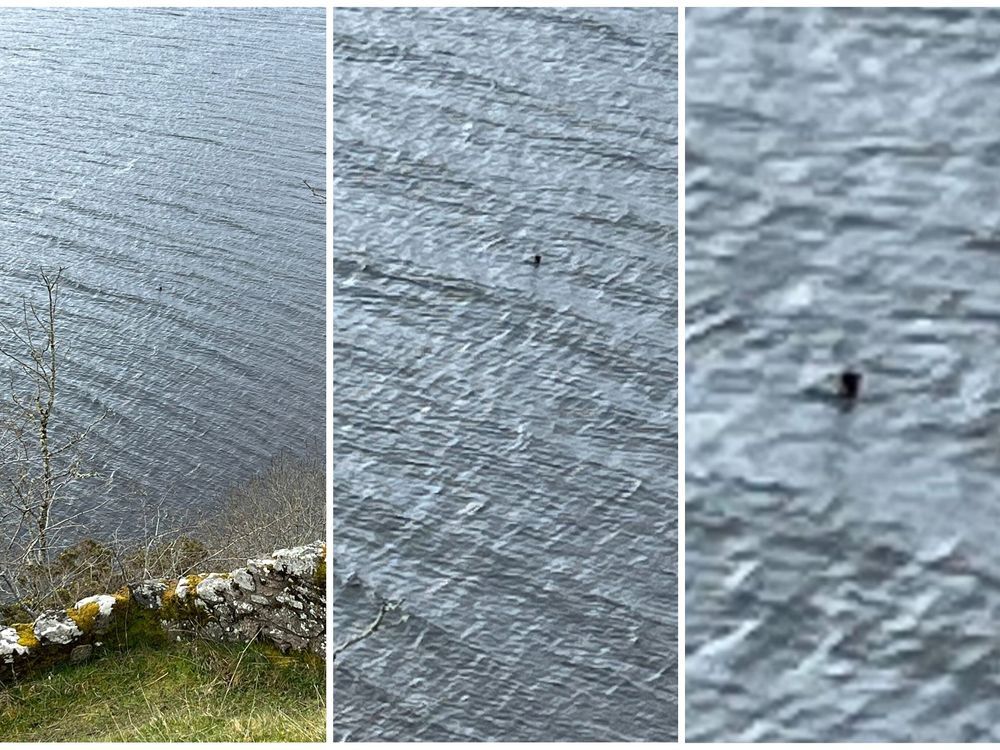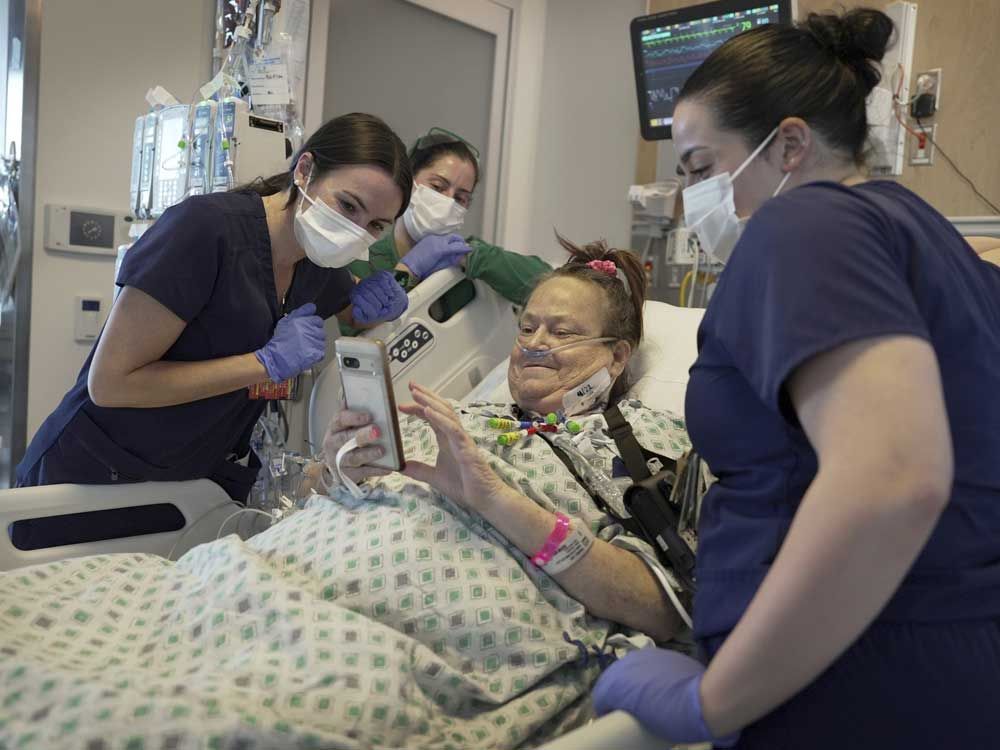'Nessie’ sighting vaults Canadian couple into media spotlight after photo in Scotland
Author of the article:Canadian Press
Canadian Press
Published Apr 24, 2024 • Last updated 1 day ago • 3 minute read
A Canadian couple, Parry Malm and Shannon Wiseman, living in England have been thrust into the limelight after capturing images, as shown in these handout images, of what could be the famed Loch Ness Monster in Scotland.
A Canadian couple, Parry Malm and Shannon Wiseman, living in England have been thrust into the limelight after capturing images, as shown in these handout images, of what could be the famed Loch Ness Monster in Scotland. PHOTO BY HO /The Canadian Press
LONDON — Parry Malm and Shannon Wiseman weren’t expecting a “pivotal moment” in their sons’ lives when they visited Scotland’s Loch Ness earlier this month, but that’s exactly what happened.
“Our youngest is turning three next week,” said Wiseman from the family’s home in London, England. “And he tells everyone there have been two pivotal moments in his life: Seeing the world’s largest dinosaur, which he did at the Natural History Museum in January, and seeing Nessie.
“He tells everyone he encounters. He tells the postman, he tells the guys in the shops and the cafes.”
Malm and Wiseman have been thrust into the limelight after a photo they took during their family vacation showed a shadowy figure poking above the waterline, something that the couple’s children — and others — firmly believe is the latest sighting of the famed Loch Ness Monster.
Malm and Wiseman, who are from Coquitlam B.C., and Calgary respectively, moved to England in 2006.
The couple said the original plan for the spring vacation was to take a boat ride in Loch Ness because their children were “completely captivated by the concept of Nessie.”
“We’d even packed shortbread cookies, which we were told from these books was Nessie’s favourite treat,” Wiseman quipped. “Turned out shortbread cookies were not necessary.”
That’s because the family spotted something sticking out of the water while visiting a lookout at nearby Urquhart Castle.
“We just started watching it more and more, and we could see its head craning above water,” Malm said. “And then it was swimming against the current towards the castle, slowly but surely, like very fastidiously going over the waves (and) coming closer and closer. And then it submerged and disappeared.”
Malm said the family took a photo of what they saw and decided “for a bit of a laugh” to send the picture to the Official Loch Ness Monster Sightings Register, which he stumbled upon while surfing the internet.
“They got in touch within 24 hours,” Malm recalled. “They were super excited. They sent it to one of their Loch Ness experts who said that it was ‘compelling evidence,’ I believe was the exact phrase.
“And just one thing led to another. I mean, it’s been incredible.”
Since the photo submission, Malm and Wiseman have been featured in British tabloids such as The Sun and the Daily Mirror and digital publication LADbible.
On the Official Loch Ness Monster Sightings Register, the encounter has been recorded as the first Nessie sighting of 2024.
“We’ve both got texts from people who we haven’t heard from in quite some time going, ‘Guess who I just saw on TV?”‘ Malm said.
“I’m just glad that we hit the national media in Canada for spotting the Loch Ness monster and not being on Crime Stoppers.”
Both Malm and Wiseman said they are happy their experience is bringing some positivity to the daily news cycle, and at least one person they have spoken with thanked them for the picture.
“Our son’s school’s headmaster is Scottish,” Malm said. “And he pulls me aside at pick up one day and he goes, ‘You know what, Perry? You’ve done more for Scottish tourism than anybody else in my lifetime.’
“So, hopefully some people will be inspired to come visit Scotland.”
What isn’t certain, however, is what they actually encountered on that cold April morning on the shore of Loch Ness.
“We don’t know what we saw,” Wiseman said. “Our children believe we saw Nessie, and I believe it for them.
“I believe that we saw something that could be Nessie, and that is a very broad possibility.”
Malm said the wonder that the sighting has inspired in his children, and others resonating with the photo, is more important than the question of what they encountered.
“It’s really charming,” he said of the outpouring of reactions. “Because in a world where the news is about a war here and an atrocity there, it’s just nice that people are interested in something that’s just lighthearted, a little bit silly and a little bit unbelievable.”
![nessie-photo-20240424[1].jpg nessie-photo-20240424[1].jpg](https://forums.canadiancontent.net/data/attachments/20/20175-7ced0144ef4c5f013da1d2496b00039a.jpg)

 torontosun.com
torontosun.com
Author of the article:Canadian Press
Canadian Press
Published Apr 24, 2024 • Last updated 1 day ago • 3 minute read
A Canadian couple, Parry Malm and Shannon Wiseman, living in England have been thrust into the limelight after capturing images, as shown in these handout images, of what could be the famed Loch Ness Monster in Scotland.
A Canadian couple, Parry Malm and Shannon Wiseman, living in England have been thrust into the limelight after capturing images, as shown in these handout images, of what could be the famed Loch Ness Monster in Scotland. PHOTO BY HO /The Canadian Press
LONDON — Parry Malm and Shannon Wiseman weren’t expecting a “pivotal moment” in their sons’ lives when they visited Scotland’s Loch Ness earlier this month, but that’s exactly what happened.
“Our youngest is turning three next week,” said Wiseman from the family’s home in London, England. “And he tells everyone there have been two pivotal moments in his life: Seeing the world’s largest dinosaur, which he did at the Natural History Museum in January, and seeing Nessie.
“He tells everyone he encounters. He tells the postman, he tells the guys in the shops and the cafes.”
Malm and Wiseman have been thrust into the limelight after a photo they took during their family vacation showed a shadowy figure poking above the waterline, something that the couple’s children — and others — firmly believe is the latest sighting of the famed Loch Ness Monster.
Malm and Wiseman, who are from Coquitlam B.C., and Calgary respectively, moved to England in 2006.
The couple said the original plan for the spring vacation was to take a boat ride in Loch Ness because their children were “completely captivated by the concept of Nessie.”
“We’d even packed shortbread cookies, which we were told from these books was Nessie’s favourite treat,” Wiseman quipped. “Turned out shortbread cookies were not necessary.”
That’s because the family spotted something sticking out of the water while visiting a lookout at nearby Urquhart Castle.
“We just started watching it more and more, and we could see its head craning above water,” Malm said. “And then it was swimming against the current towards the castle, slowly but surely, like very fastidiously going over the waves (and) coming closer and closer. And then it submerged and disappeared.”
Malm said the family took a photo of what they saw and decided “for a bit of a laugh” to send the picture to the Official Loch Ness Monster Sightings Register, which he stumbled upon while surfing the internet.
“They got in touch within 24 hours,” Malm recalled. “They were super excited. They sent it to one of their Loch Ness experts who said that it was ‘compelling evidence,’ I believe was the exact phrase.
“And just one thing led to another. I mean, it’s been incredible.”
Since the photo submission, Malm and Wiseman have been featured in British tabloids such as The Sun and the Daily Mirror and digital publication LADbible.
On the Official Loch Ness Monster Sightings Register, the encounter has been recorded as the first Nessie sighting of 2024.
“We’ve both got texts from people who we haven’t heard from in quite some time going, ‘Guess who I just saw on TV?”‘ Malm said.
“I’m just glad that we hit the national media in Canada for spotting the Loch Ness monster and not being on Crime Stoppers.”
Both Malm and Wiseman said they are happy their experience is bringing some positivity to the daily news cycle, and at least one person they have spoken with thanked them for the picture.
“Our son’s school’s headmaster is Scottish,” Malm said. “And he pulls me aside at pick up one day and he goes, ‘You know what, Perry? You’ve done more for Scottish tourism than anybody else in my lifetime.’
“So, hopefully some people will be inspired to come visit Scotland.”
What isn’t certain, however, is what they actually encountered on that cold April morning on the shore of Loch Ness.
“We don’t know what we saw,” Wiseman said. “Our children believe we saw Nessie, and I believe it for them.
“I believe that we saw something that could be Nessie, and that is a very broad possibility.”
Malm said the wonder that the sighting has inspired in his children, and others resonating with the photo, is more important than the question of what they encountered.
“It’s really charming,” he said of the outpouring of reactions. “Because in a world where the news is about a war here and an atrocity there, it’s just nice that people are interested in something that’s just lighthearted, a little bit silly and a little bit unbelievable.”
![nessie-photo-20240424[1].jpg nessie-photo-20240424[1].jpg](https://forums.canadiancontent.net/data/attachments/20/20175-7ced0144ef4c5f013da1d2496b00039a.jpg)

'Nessie’ sighting vaults Canadian couple into media spotlight after photo in Scotland
Parry Malm and Shannon Wiseman weren't expecting a "pivotal moment" in their sons' lives when they visited Scotland's Loch Ness earlier this month.

